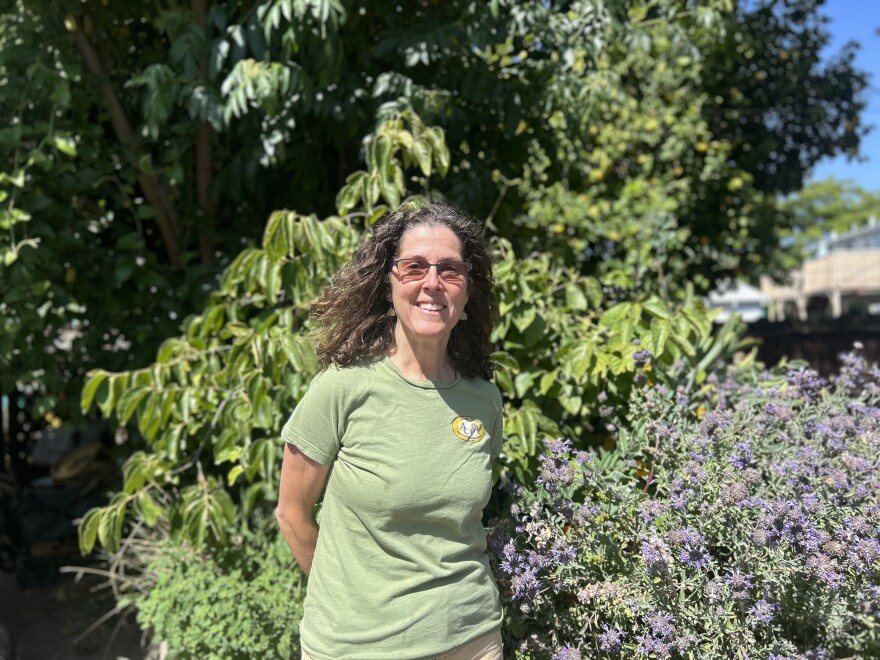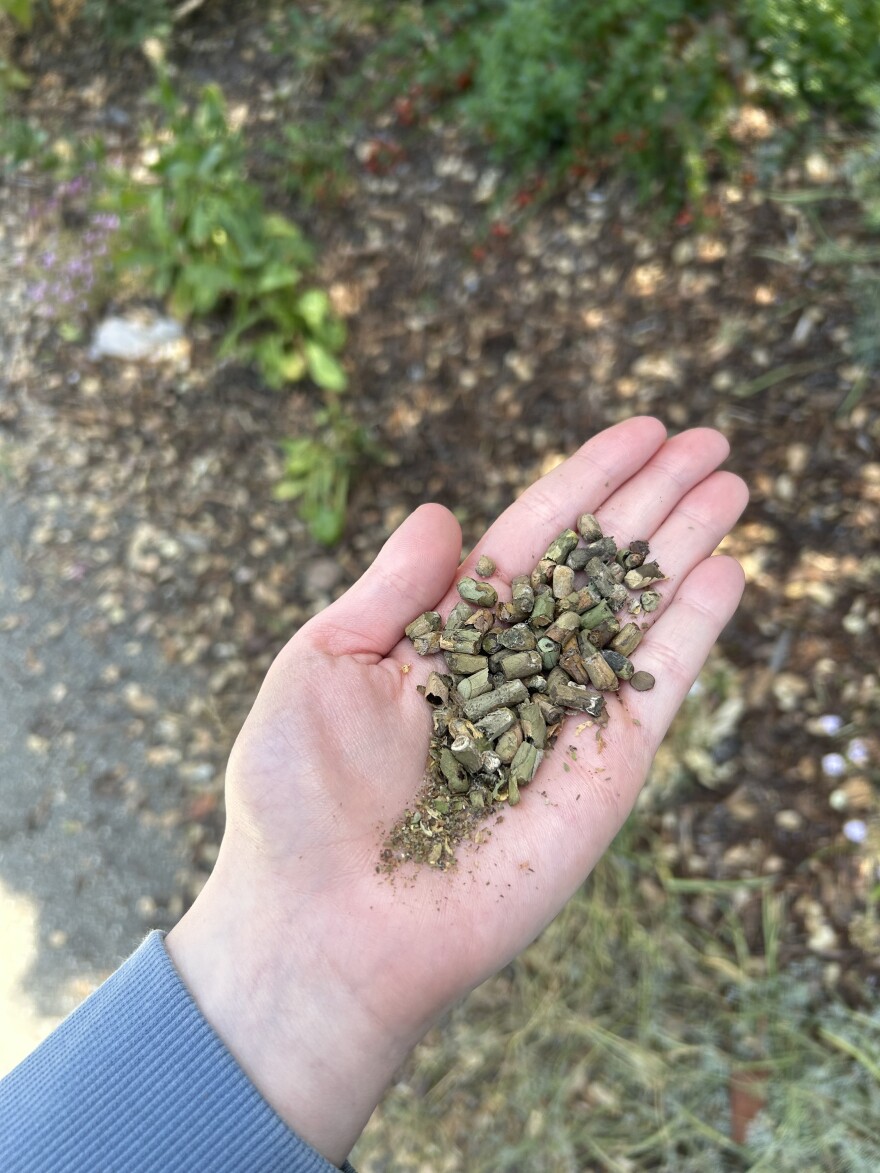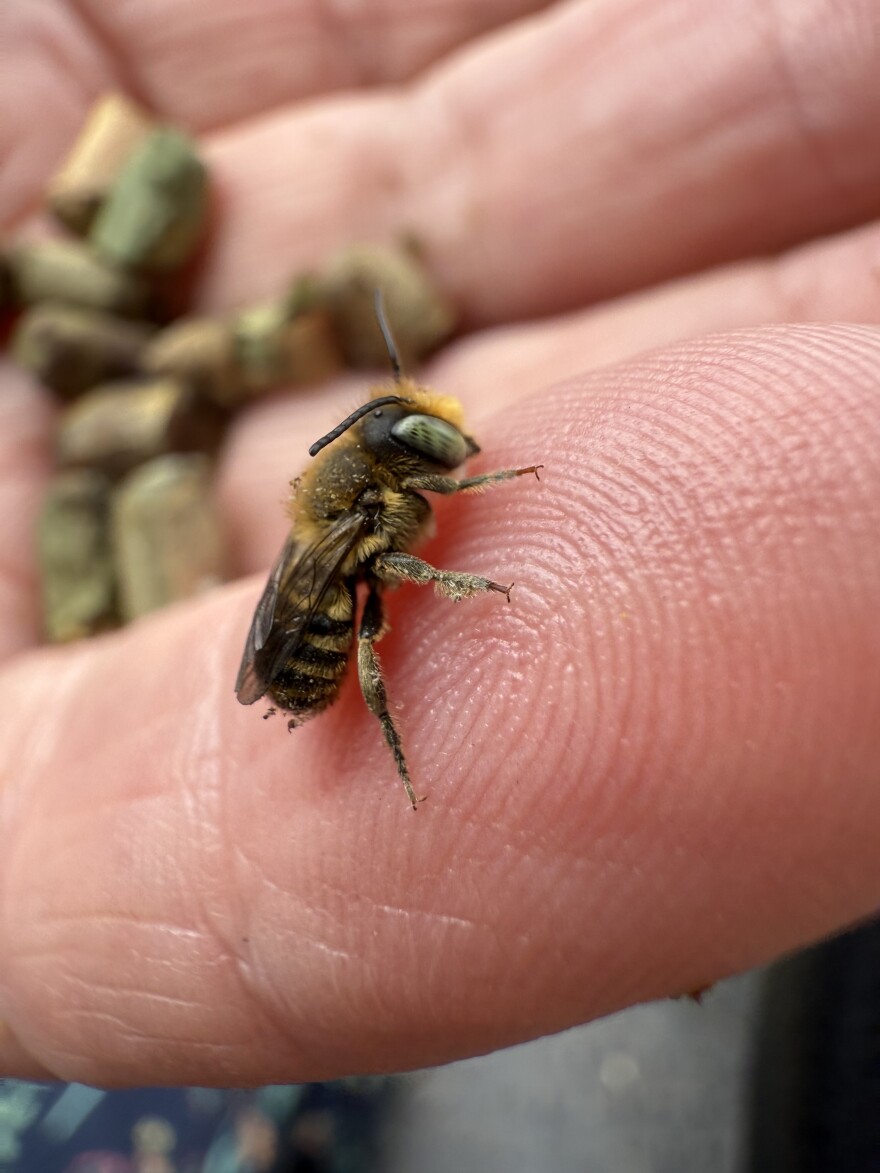This story aired in the August 25, 2025 episode of Crosscurrents.
California has 1,600 native bees, and yet we are more likely to hear about their non-native counterpart: the honey bee. But gardeners and researchers alike, in the Bay and across the state, are trying to get the word out about native bees.
Click the button above to listen!
Story Transcript:
HANA BABA: We’re starting today’s show in a backyard in San Leandro. Paula Breen is an avid beekeeper, which is why her yard sounds like this:
Sounds of bees buzzing.
HANA BABA: Actually her yard is a little louder than usual. Instead of her regular three hives, there are 12 here. That’s because spring and early summer is swarming season, when beehives reproduce, and Paula is a first responder for a swarm hotline.
PAULA BREEN: If you're a homeowner and a swarm of bees lands in your yard and you're freaking out, you can call the number and, uh, someone will take all the information. They blast out the information to the whole club.
HANA BABA: Any member of the Alameda County Beekeeper’s Association can answer the call. When Paula does, she hops into her fully electric Mustang and books it to the bees.
PAULA BREEN: This swarm was really high up in a tree. And, um, there was no way to get them down.
HANA BABA: She ended up convincing a local firefighter to climb up his fire truck ladder with a fruit-picker taped to a pole to grab the bees.
PAULA BREEN: It was quite a hair-raising experience, but it was fun. [Laughs]
HANA BABA: Paula loves rescuing swarms and keeping bees. But, she’s become more wary the more she’s learned. Like, honey bees aren’t native to California, or even the United States.

PAULA BREEN: It's so funny, I remember when I first got them, I mean, I was just so smitten. And I, I can remember saying to one of my colleagues at work like, “Everybody should keep bees.” And now I'm like, “Everybody should totally not keep bees.”
THANA BABA: That’s because those honey bees could actually be causing harm to California’s native bees. And that’s not great for our ecosystems. KALW’s Ellie Prickett-Morgan has the story.
REPORTER: Leif Richardson says he knows that America has a bit of a love affair with honey bees.
LEIF RICHARDSON: It's uncomfortable actually to hear that honey bees might not be good.
REPORTER: Leif is a conservation biologist with Xerces Society. They work with bees. Native bumble bees, that is, not honey bees.
LEIF RICHARDSON: They are a livestock animal that is invasive throughout much of our country.
REPORTER: In the US, honey bees are closer to cows and chickens if you’re thinking in terms of ecosystems. Leif says we should think of them like farm animals.
Honey bees came to the US by boat in the 1600s. Early colonists wanted their wax for candles. The first documented hive to make it to California came via donkey from New York 1853. That means honey bees have only been in the state as long as Levi’s jeans.
In the past hundred years, huge swaths of California – especially in the Central Valley – were cleared and adapted for industrial agriculture. This destroyed grassland, streams, forests, and wetlands — all ecosystems that were home to native pollinators.
But farmers still needed a reliable way to pollinate their crops, so a new practice, one that relied on honey bees, was born: mobile pollination.
LEIF RICHARDSON: You can't grow almonds without a lot of water. You can’t grow almonds without a lot of bees. It's just a fact.
REPORTER: In California more than 2 million hives are temporarily shipped into the state to pollinate almond orchards every year. They come by truck or sometimes by plane. It’s a $4 billion industry.
But Leif says that honey bees, as important as they are to our farm system, could actually be harming the natives in two big ways.
LEIF RICHARDSON: There's very good evidence that honey bees are having negative impacts on bumble bees and some other bees through just competition for pollen and nectar.
REPORTER: Unlike honey bees, the natives are mostly solitary. One lone bee, no matter how efficient, can’t beat out a whole hive on the same flower beds.
Another problem is that honey bees can spread diseases and pathogens to native bees.
LEIF RICHARDSON: There are these RNA viruses that honey bees get deformed wing virus is a good example some people have heard of. It causes the bees to be born from their pupa without wings, and that's pretty much a death sentence for a bee. Those things do cross state lines and do end up in wildlands where they're shared as flowers with wild bees.
REPORTER: In June I traveled to San Luis Obispo where Leif was leading a California Bumblebee Atlas event. It’s an annual project, with volunteers all over the state identifying and counting bumble bees. That’s where I met Tate Isaacs, who was catching and handling bumble bees for the first time.
TATE ISAACS: Ok got this in my other hand now… (rustling noises, zipper noise). Okay.
REPORTER: Tate unzips his pocket to grab a plastic vial. There’s a male Yellow-faced Bumble Bee in his net that he now has to coax inside.
TATE ISAACS: I just want to get the cap ready before I… (Buzzing noises, clink).
REPORTER: Nice.
TATE ISAACS: Did I get it??
REPORTER: He did! Tate was actually one of the first of 30 volunteers to capture a bumble bee. Once it was safely in the vial, he labelled it and handed the vial to another volunteer, Cindy Roessler. She then puts it into a cooler full of ice.
CINDY ROESSLER: Do you remember what you caught it on? TATE
ISAACS: Yea, the bee plant…
REPORTER: Forty minutes later, the ice in the coolers has made the bees sleepy and easy to handle.

LEIF RICHARDSON: It can take 10 to 30 minutes to warm up, but you can see she's starting to move. At some point, the bee will stand up and start walking around.
REPORTER: Leif teaches volunteers how to photograph and document them.
LEIF RICHARDSON: I've told you we wanna see photos of the underside, so I can easily hold it upside down and take those photos.
REPORTER: Then one by one the bees wake up and fly into the brush. All of this information – the bees that are captured, what plants they were on – is part of the data collection process.
By the end of an hour-long walk through Montaña de Oro State Park, Tate caught 6 native bumble bees; the whole group caught nearly a hundred.
TATE ISAACS: This has totally inspired me to get more involved with other community science projects. It's been super fun.
REPORTER: I feel like it, there's something about getting like a net and getting to run around that feels very kindergarten, but in a good way.
TATE ISAACS: In the best way, for sure.
REPORTER: Leif tells me that California Bumblebee Atlas events like this one, produced 7,500 individual native bumble bee observations last year.
LEIF RICHARDSON: It's a huge volume of data that I could never collect myself as a scientist or as a specialist or something.
REPORTER: Collecting that much data is a big deal — Xerces used it to put the Rusty Patched Bumble bee on the endangered species list in 2017. Right now they’re trying to do the same for California’s Morrison Bumble bee so it can have the same protections.
The whole atlas process is labor intensive for Leif, but it is a labor of love for the native bees that support native plants, pollinate crops, and prop up our whole ecosystem.
LEIF RICHARDSON: I said earlier to someone that I feel like a traveling preacher when I do this, because I personally feel like the qualities of bumble bees and the mission of trying to keep them from becoming rare, is almost faith-based in a way.
REPORTER: And part of that process of conversion is simply to let people get to know California’s native bees. Something that Tora Rocha is doing in Oakland. So let me introduce you to some:
Buzzing noises and park ambiance.
REPORTER: Do you hear that tiny little buzz? What about that faint static-y crackle that sounds kind of like when you first pour milk over rice krispies? Well that's the sound of two dozen baby leaf-cutter bees in the palm of my hand, slowly trying to cut their way out of their winter cocoons.
I didn’t just happen on these cocoons though, Tora brings them out for me. We meet at the Gardens at Lake Merritt.

Sounds of golf cart driving.
TORA ROCHA: So this is the pollinator gardens right here.
REPORTER: She drives me around in her golf cart.
TORA ROCHA: …that tequila sage is huge.
Golf cart creaks.
REPORTER: Tora had a decades-long career in Oakland Parks, as a gardener, a greenskeeper, and eventually park supervisor. And she’s always been passionate about wildlife — she actually started her career in Oakland training elephants for the Oakland Zoo. But now she’s turned her focus to smaller fauna.
TORA ROCHA: I had this epiphany after watching Queen of the Sun
REPORTER: The 2010 documentary about colony collapse disorder. Even though it was about honey bees, it pushed Tora to start talking to entomologists and learn about native pollinators.
TORA ROCHA: I just woke up at two in the morning and I was like, “Oh, it's not farmers and pesticides, it's all of us. It's how we landscape, how we look at landscapes, what we are doing with landscapes and the habitat.” And I'm like, “We have to make a difference.”
REPORTER: Tora then co-founded the Pollinator Posse. Their mission is to educate the public about native pollinators, and what we can do to protect them.
And Tora changed her perspective on certain landscaping practices — like clearing dead trees from Oakland’s parks. She learned that deadwood was actually habitat for about a third of California’s native bees, like the leaf-cutter.
TORA ROCHA: So I asked the director of public works at the time, my boss, if I could have a bee hotel built in the gardens and can we have the city carpenter build it?
REPORTER: A bee hotel! It's like if you reverse engineered a dead tree with little holes carved into it. The bee hotel at lake merrit is now more than a decade old, and it looks kind of like a bookshelf plopped into the middle of a flower bed. Up close you'll see hundreds of little wooden tubes, where little leaf-cutter bees and other wood cavity nesters can lay their eggs.
But Tora admits the deadwood is still the better habitat option.
TORA ROCHA: I tell people, instead of stumping it and pulling the tree out, cut it to chest high and drill holes on it on the northeast side, and then you have a bee hotel and you didn't have to remove a stump.
REPORTER: Tora says a big problem is that most people don’t see their gardens as ecosystems, so they make aesthetic choices that are harming native bees.
As we drive through the gardens, overgrown plants thwack against the golf cart. The result of what Tora calls “gentle landscaping”.
TORA ROCHA: A lot of native bees use hollow stems like salvias and stuff, so if you're constantly deadheading and cutting back, you're probably removing nesting, you know?
REPORTER: And a slightly overgrown garden can still be beautiful — even on a weekday, during work hours, tons of people are walking around and taking in the sights at the gardens. Tora sees this as a prime opportunity to spread the word about native bees.

TORA ROCHA: You guys wanna see baby native bees?
REPORTER: Tora sees three visitors and puts on the pollinator posse charm.
TORA ROCHA: They, they, everyone was calling me the Queen Bee and I'm like, no, no, no, that's Beyonce.
REPORTER: She leans over from the golf cart and opens a cardboard tube. Carefully she pours out dozens of leaf-cutter cocoons into the outstretched palms of three visitors. The cocoons, made of dried leaves, are tiny, each about the size of a pencil eraser.
Anthony Martinez, an Oakland native who had never held a bee before, is charmed by the leaf-cutters.
ANTHONY MARTINEZ: Seeing them wake up and open their little eyes and crawl out is just like, they're little. They're little guys. They're really cute. I like 'em more.
REPORTER: Tora is quick to point out that the biggest thing native bees need for protection are big structural changes. Industrial pesticide use, big ag, mobile pollination, that’s not something that any one person can fix. But she still thinks that the first step to getting there is spreading the word that native bees are here at all.
TORA ROCHA: I think introducing them to 'em and letting them see, like that little leaf cutter bee, how small. It's like that's a native bee? They're so geared that only honey bees are bees…
REPORTER: So consider this an introduction to at least one of 1,600 species of bees you can meet in California.
Buzzing sounds come back.
REPORTER: This static-sound is 50 of Tora’s native leaf-cutters saying hi. Even when they’re not visible or audible, they leave behind perfect circular cutouts in soft foliage, like rose petals. And there are still many more bees to meet.


